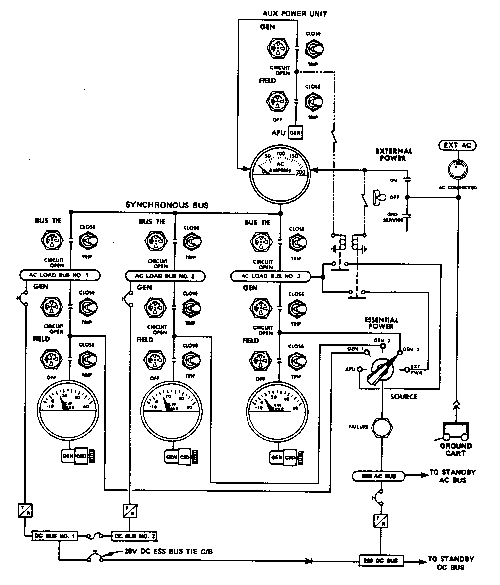
BOEING 727 ELECTRICAL SYSTEM

Constant Speed Drive (CSD)...
In flight, electrical power on the Boeing 727 is provided by three Alternating Current (AC) generators that produce 115 volts at a frequency of 400 cycles per second. In order to generate this output, the generators turn at a constant RPM through the use of a Constant Speed Drive (CSD).
The CSD is a type of transmission between the generator and the N2 Accessory Drive. It maintains a constant 6,000 RPM to the generator regardless of engine speed. Additionally, the CSD provides a means of disconnecting the generator from the engine (CSD Disconnect) should the need arise. CSD's cannot be "reconnected" in flight and must be reset on the ground. Should the malfunctioning CSD not disconnect from the N2 Accessory Drive, the associated engine should not be run above idle RPM.
There are two methods of reading CSD temperature:
"Rise" temperatures are the best indication of how hard the CSD is being worked. High Rise temperatures indicate a heavy load on the generator as they indicate how much oil is being heated as it passes through the CSD
"In" temperatures indicate how effectively the CSD oil is being cooled.
CSD oil is cooled by ram air in flight. On the ground, 13th stage bleed air is injected into the cooling duct downstream of the heat exchanger which draws outside air (cooler) into the duct. This is done by placing the CSD Oil Cooler switch in the NORMAL position.
AC Electrical System...
The three aircraft generators will produce 115 volts AC (+/- 5 volts) at a frequency of 400 cycles per second (+/- 8 CPS). The generators use residual voltage to produce the magnetic field necessary to produce 115 volts AC. Normal residual voltage is 12 to 15 volts.
With the generator field relays closed, the generators can produce current for the aircraft's electrical equipment. The current flows through four AC load busses. (A "bus" is simply a common source of electrical power for a number of different circuits.) Each generator (3) has its own load bus with the fourth load bus being the Essential AC Bus.
The Essential AC Bus can draw current from any operating generator. The generator which supplies the Essential AC Bus is selected by the Essential Power Source selector. The Essential AC Bus provides power to items which are important to the safety of flight. When any electrical system malfunction occurs, first action is to ensure that this power bus is energized. With the generator breakers tripped, the generators are isolated from all loads except essential loads.
The Synchronous (SYNC) bus allows the generators to share loads and provides a way of supplying power to all busses if a generator becomes inoperative. Bus Tie Breakers (BTB) connect each of the generator load busses to the SYNC bus and the other load busses supply current to it.
Before two generators can supply power to a common source (SYNC bus), they must be in phase with each other. This can be done by using either the generator breakers (automatic paralleling) or the bus tie breakers (manual paralleling). Normal procedure is to automatically parallel the generators.
KW/KVAR meters indicate generator load. Although they normally indicate KW (real load), they can indicate KVAR (reactive load) when the KVAR switch is pressed. With all generators supplying power to the SYNC bus, all loads should be shared equally. Maximum load difference between generators is 7 KW or 3 KVAR.
DC Electrical System...
The Boeing 727 has a 28-volt DC system for those items that require direct current. DC is provided by converting 115-volt AC power from busses 1,2 and Essential into 28-volt DC through the use of transformer-rectifier (T.R.) units. The transformer reduces the voltage from 115 volts to 28, and the rectifier converts AC to DC. Normal T.R. voltage with no load is 29.5 (+/-1) volts and with a load is 25.5 - 28.5 volts.
Standby Power...
If all AC power is lost, standby (STBY) power should be selected. This supplies battery power to essential flight instruments and navigation/communication equipment. The selection of STBY power does not power all of the items on the essential bus.
The battery used for STBY power and also for APU start (same battery does both) is a nickel-cadium battery. A fully-charged battery would indicate 25 to 28 volts with a pulsating amperage. Minimum battery voltage with AC power off is 22 volts.